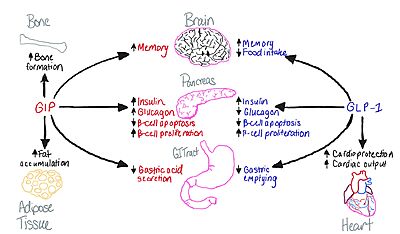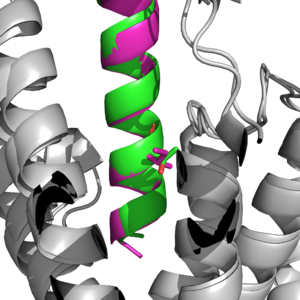User:SaraKathryn Kalkhoff/Sandbox 1
From Proteopedia
(Difference between revisions)
| Line 4: | Line 4: | ||
== Introduction == | == Introduction == | ||
[https://www.sciencedirect.com/topics/medicine-and-dentistry/gastric-inhibitory-polypeptide The Glucose-dependent Insulinotropic Polypeptide (GIP) is a ligand that can be bound to its receptor (GIP-R) to help facilitate the breakdown of glucose.] This is the basis of what makes up one of the key ways that glucose is bound and broken down into different parts, including insulin, to be able to maintain blood glucose levels within the body. With this structure, it is also to work with the GLP-1 receptors found within cells to help break down glucose present within cells to create energy. Unfortunately for many people with diabetes, they are unable to bring in as much glucose from the GLUT-1 transporter found within a cell and causes a higher blood glucose level that can become toxic if left untreated <ref name ='Seino'>DOI:10.1111/j.2040-1124.2010.00022.x</ref>. | [https://www.sciencedirect.com/topics/medicine-and-dentistry/gastric-inhibitory-polypeptide The Glucose-dependent Insulinotropic Polypeptide (GIP) is a ligand that can be bound to its receptor (GIP-R) to help facilitate the breakdown of glucose.] This is the basis of what makes up one of the key ways that glucose is bound and broken down into different parts, including insulin, to be able to maintain blood glucose levels within the body. With this structure, it is also to work with the GLP-1 receptors found within cells to help break down glucose present within cells to create energy. Unfortunately for many people with diabetes, they are unable to bring in as much glucose from the GLUT-1 transporter found within a cell and causes a higher blood glucose level that can become toxic if left untreated <ref name ='Seino'>DOI:10.1111/j.2040-1124.2010.00022.x</ref>. | ||
| - | [[Image:Gip glp.jpeg|400 px|right|thumb|Figure 1: | + | [[Image:Gip glp.jpeg|400 px|right|thumb|Figure 1: Distinction of functions between the GIP and GLP-1 receptors.]]` |
== Function == | == Function == | ||
The GIP receptor helps facilitate movement of glucose within a cell. <ref name='Sun'>PMID:35333651</ref>. It has a natural ligand that is 42 residues and helps kickstart the GIP-R into firing, as a transporter for glucose in and out of the cell. Once the levels become too high, the ligand will send this transporter back down into the cell and not have anymore glucose activate. It will also cause the insulin pathway to start to help signal that there is too much glucose in the body. As mentioned above, many issues that arise with diabetes can affect the rate of transport within these transporters for the cell. | The GIP receptor helps facilitate movement of glucose within a cell. <ref name='Sun'>PMID:35333651</ref>. It has a natural ligand that is 42 residues and helps kickstart the GIP-R into firing, as a transporter for glucose in and out of the cell. Once the levels become too high, the ligand will send this transporter back down into the cell and not have anymore glucose activate. It will also cause the insulin pathway to start to help signal that there is too much glucose in the body. As mentioned above, many issues that arise with diabetes can affect the rate of transport within these transporters for the cell. | ||
| Line 12: | Line 12: | ||
<scene name='10/1037492/Gip_tirz/7'>Main scene of Tirzepatide bound to the GIP receptor. </scene> Tirzepatide and the natural GIP for the receptor contain some key differences, but they are all able to bind with a strong affinity to the receptor. Some of the different molecules could be useful into explaining why a tirzepatide molecule is able to bind at a stronger affinty for the receptor than the ligand that will bind and cause a cascade to start a signaling pathway for more binding. | <scene name='10/1037492/Gip_tirz/7'>Main scene of Tirzepatide bound to the GIP receptor. </scene> Tirzepatide and the natural GIP for the receptor contain some key differences, but they are all able to bind with a strong affinity to the receptor. Some of the different molecules could be useful into explaining why a tirzepatide molecule is able to bind at a stronger affinty for the receptor than the ligand that will bind and cause a cascade to start a signaling pathway for more binding. | ||
=== Active Site === | === Active Site === | ||
| - | Main binding domains between tirzepatide and the GIP receptor would contain an arginine 190 and glutamine 220 residues to facilitate binding of the ligand. The binding is also able to use a tyrosine residue at position 1 that helps guide the ligand into the correct binding spot <ref name='Sun'>PMID:35333651</ref>.One key difference found was a point mutation at position 7 between an Isoleucine and Threonine <ref name='Sun'>PMID:35333651</ref>, which would result in a higher affinity for the tirzepatide molecule binding onto the receptor than the ligand. Due to the change of a nonpolar residue turning to a polar with the ability to hydrogen bond onto the R190 and Q220, making it a | + | Main binding domains between tirzepatide and the GIP receptor would contain an arginine 190 and glutamine 220 residues to facilitate binding of the ligand. The binding is also able to use a tyrosine residue at position 1 that helps guide the ligand into the correct binding spot <ref name='Sun'>PMID:35333651</ref>.One key difference found was a point mutation at position 7 between an Isoleucine and Threonine <ref name='Sun'>PMID:35333651</ref>, which would result in a higher affinity for the tirzepatide molecule binding onto the receptor than the ligand. Due to the change of a nonpolar residue turning to a polar with the ability to hydrogen bond onto the R190 and Q220, making it a stronger site for binding. With this higher binding affinity, the ligand of tirzepatide is able to interact with the transporter and add in glucose to the cell. |
[[Image:i7_vs_t7.png|300px|left|thumb|Figure 2: Key difference between GIP ligand and Tirzepatide at position 7. Ile7 is in pink (ligand), and Thr7 is in aqua(tirzepatide).]] | [[Image:i7_vs_t7.png|300px|left|thumb|Figure 2: Key difference between GIP ligand and Tirzepatide at position 7. Ile7 is in pink (ligand), and Thr7 is in aqua(tirzepatide).]] | ||
== References == | == References == | ||
Revision as of 14:13, 16 April 2024
| |||||||||||


